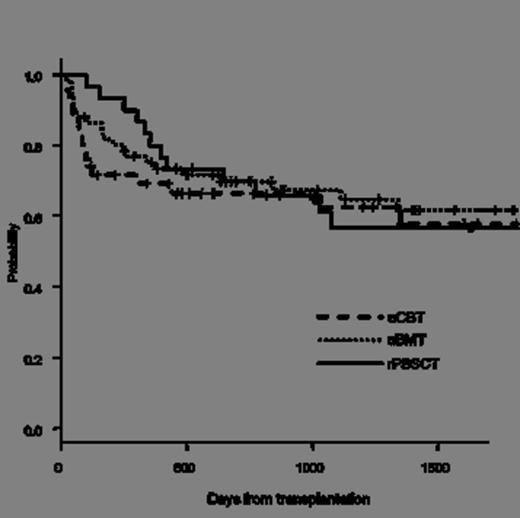Abstract
Comparable 2-year overall and progression free survival among unrelated cord blood, unrelated bone marrow, and related peripheral blood stem cell transplantation in adult patients with standard-risk hematological diseases; A single center retrospective analysis
Cord blood has become one of the major alternative donor sources for those who lack identical related donors in recent years. In Japan, an annual number of unrelated cord blood transplantation (uCBT) has been increasing and it reached 1179 cases in 2012, which is comparable to those of unrelated bone marrow transplantation (uBMT) and related peripheral blood stem cell transplantation (rPBSCT). So far, there is still limited data available on the comparative outcomes of adult standard risk patients receiving uCBT, uBMT and rPBSCT.
To compare the outcome of uCBT with those of uBMT and rPBSCT for adult patients with standard-risk hematological diseases, we retrospectively reviewed medical records of 142 patients with standard risk hematological diseases who underwent first allogeneic hematopoietic stem cell transplantation (allo-HSCT) at Toranomon Hospital from Jan 2005 to December 2011. The definition of standard risk disease is severe aplastic anemia (SAA), myelodysplastic syndrome (MDS) in refractory anemia (RA), refractory anemia with ringed sideroblasts (RARS), and refractory cytopenia with multilineage dysplasia (RCMD), acute leukemia in complete remission (CR) 1 or 2, chronic myeloid leukemia in chronic phase, non-Hodgkin lymphoma (NHL) in CR, and adult T-cell leukemia/lymphoma (ATL) in CR. Patients with active infection were excluded.
The median follow-up day of survivors was 654 (19-2745). The characteristics of patients are summarized in Table 1. Forty-six patients performed uCBT, 66 did uBMT, and 30 did rPBSCT. The median age of the patients was 50 years (range, 16-70). There were more elderly patients in uCBT group than uBMT and rPBSCT groups (p=0.009). Cumulative incidence of neutrophil recovery at 50 days after transplantation was lowest in uCBT group and highest in rPBSCT group (uCBT= 87.1%, uBMT= 94.7%, rPBSCT=100%; P<0.001). Among 9 patients who did not engraft after uCBT, 6 achieved engraftment following 2nd uCBT. The cumulative incidence of grade II-IV acute graft-versus-host disease was comparable in three groups (uCBT= 43.7%, uBMT= 52.7%, rPBSCT=46.7%, P=0.57). Overall survival (OS) (uCBT=66.4%, uBMT=69.7%, rPBSCT=69.8%, P=0.73)(Figure 1), disease free survival (DFS) (uCBT=63.0%, uBMT=63.7%, rPBSCT=63.2%, P=0.82), relapse rate (uCBT=14.8%, uBMT=14.7%, rPBSCT=20.2%, P=0.67), and treatment related mortality (TRM) (uCBT=19.6%, uBMT=21.6%, rPBSCT=16.7%, P=0.52) at 2 years were all comparable among 3 groups.
Clinical outcomes of uCBT, uBMT and rPBSCT groups for adult standard-risk hematological diseases were comparable. Early death is prominent in uCBT, but the increase of late relapse and GVHD-related complications in rPBSCT offset it. Although immune cells in CB are primarily immature, comparable incidence of relapse with other donor sources indicate sufficient anti-tumor effect of uCB for longterm. uCB can now be considered as a promising donor source almost equivalent to uBM or rPB for adult standard-risk hematological diseases.
No relevant conflicts of interest to declare.
Author notes
Asterisk with author names denotes non-ASH members.



This feature is available to Subscribers Only
Sign In or Create an Account Close Modal